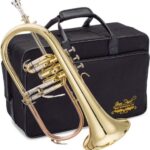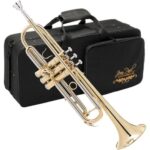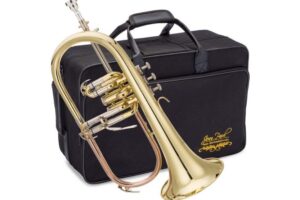At a distance, they look the same. But if you take a closer look, you will see that they are different. Flugelhorn vs trumpet – what is the difference between them?
It is their timbre that makes them different from each other. The flugelhorn’s timber is mellower, darker, and fatter than the trumpet. Many people describe the sound of the flugelhorn as halfway between a French horn and a trumpet.
The flugelhorn is also more challenging to learn and play than the trumpet. There are more intonation challenges in playing the flugelhorn because of its V-shape mouthpiece and a conical bore. In addition, it is harder to project its mellower sound.
Read on to learn more about the flugelhorn and the trumpet, their differences, and more.
Also, we hope you find the links here useful. We may get a commission if you purchase something through a link on this page, so thank you!
Flugelhorn Vs Trumpet
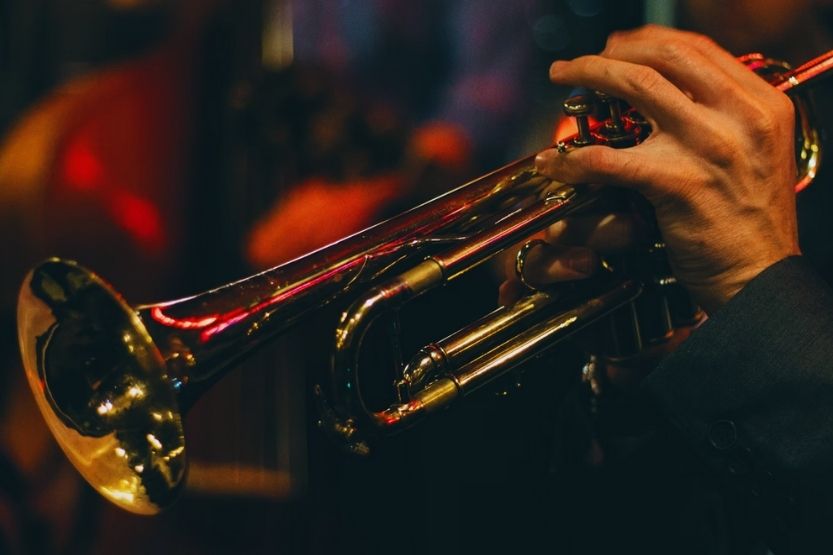
Look the Same from a Distance
The flugelhorn and the trumpet look the same from a distance. But you can see the difference between the flugelhorn and trumpet when you look at them closely. They have subtle differences in appearance. But that’s not the only difference between these two.
Differ in Timber, Build, and Use
These instruments differ in timber, build, and use. Moreover, the flugelhorn’s tone is mellower, fatter, and darker in terms of sound. Its sound is halfway between a French horn and a trumpet.
Learning to Play the Flugelhorn Is Harder
In terms of difficulty in learning, it is harder to learn the flugelhorn than the trumpet. Due to its V-shape mouthpiece and its conical bore, flugelhorn players find intonation challenging. The sound of a flugelhorn is also harder to project because it is more mellow. This is why beginners should start learning the trumpet before doing the flugelhorn.
Trumpet Is Lighter
The flugelhorn is also a bit heavier than the trumpet. However, when you stretch their pipes or tubes to their full-lengths, you will find that their overall lengths are nearly the same.
Brighter Tone from the Trumpet
The primary reason why the trumpet produces a brighter tone than the flugelhorn is that its pipe or tubing has the same diameter throughout the entire length of its body. Its diameter only expands when it reaches the bell section of the instrument.
Trumpet Takes Lead in an Orchestra
In general, the trumpet is your instrument if you want to take the lead role in an orchestra or band. It would also enable you to delve into different music genres. The flugelhorn is more for people who want to play unique music or prefer specific genres where this instrument is required.
Flugelhorn vs Trumpet Bare Facts
Flugelhorn
Click here to see this Jean Paul USA Flugelhorn (FH-430) on Amazon.
The flugelhorn belongs to the brass section of a band or an orchestra. It is similar to a cornet but has a wider conical bore. There are three valves in this instrument. It is similar to a trumpet because it can also produce B-flat tones.
Its name was taken from a German word that means flank or wing horn. Aside from producing B-flat tones, it is similar to a trumpet because it has the same tube length. What makes them very different from each other is their conical bore. The conical bore of the flugelhorn is wider than that of the trumpet.
Trumpet
Click here to see this Mendini By Cecilio Bb Trumpet on Amazon.
The trumpet also belongs to the brass section of any band or orchestra. Trumpets are generally tuned to the key of B-flat. They are usually the key instrument in jazz bands and classical ensembles. The trumpet is popular among the members of the brass family.
This instrument was used as a signaling device in war and hunting during ancient times. It was only during the 14th century when people began to use it as a musical instrument. Since then, the trumpet became a key member of musical ensembles such as jazz bands, orchestras, and concerts.
Key Differences Between Flugelhorn and Trumpet
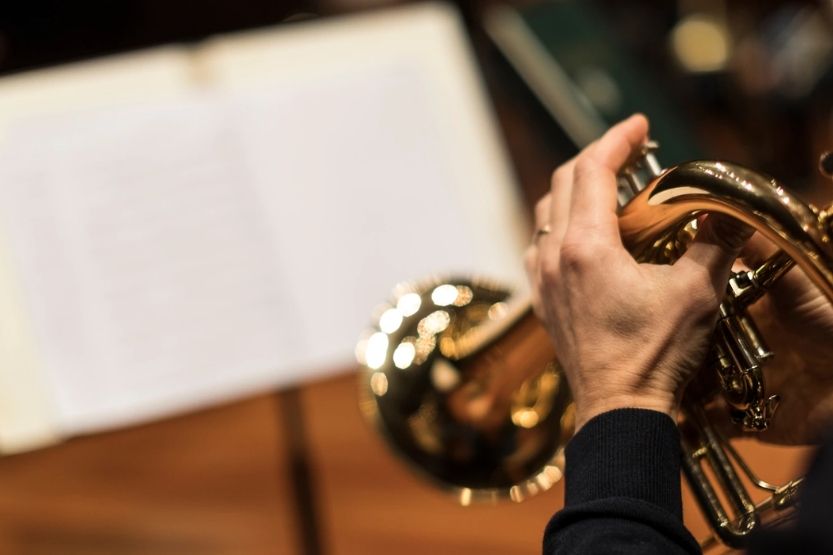
While they share similarities in their appearances, these two instruments are different. They both belong to the family of brass instruments, but like members of a human family, they have different roles to play.
Here are some of their key differences:
1. Bores
Two-thirds of the bore of a flugelhorn is conical, and only one-third of its bore is cylindrical. Meanwhile, two-thirds of the bore of the flugelhorn is cylindrical, while only one-third of its bore is conical.
The differences in their bores affect the tones that they produce. The conical bore of the flugelhorn enables it to make a warmer tone and a few upper harmonics. Meanwhile, the cylindrical bore of the trumpet allows for it to produce a brighter tone and a lot more upper harmonics.
So, while they may look the same, the sound of the flugelhorn is warmer than the trumpets. That’s the reason why the trumpet is the preferred brass instrument for high-pitched musical scores than the flugelhorn.
2. Mouthpieces
The sound produced by brass instruments like the trumpet, French horn, tuba, flugelhorn, and many others, are determined primarily by their mouthpieces. The trumpet’s mouthpiece is in the shape of a hollow cup, while the flugelhorn’s mouthpiece is deep funnel-shaped.
When the mouthpiece is shallow in brass instruments, the instrument will produce a brighter tone. On the other hand, the brass instrument will produce a warmer tone when the mouthpiece is deeper.
3. Uses
Since the trumpet generally produces brighter tones, it is the preferred brass instrument when bright tones are required in the music piece. If you assign the brighter tones to a flugelhorn, it may be able to produce the pitch, but the sound you’ll hear will more likely not be pleasing to your ears.
But if the music piece calls for warmer tones, the ‘go to’ brass instrument will more than likely be the flugelhorn. Its sound is not as penetrating as the trumpet. But it is warmer, fatter, and mellower.
4. Ranges
Technically, the flugelhorn and the trumpet ranges tend to be the same. However, because of the different qualities of their tones, they have different practical musical applications.
This means, most brass instrumentalist tends to play the flugelhorn lower. They play notes below middle C on the flugelhorn rather than on the trumpet. The sound is much nicer on the flugelhorn than on the trumpet.
For notes above high C, they tend to play it with trumpets and not with flugelhorns. The sound of high Cs is better on trumpets. They are harder to play and become less effective when played on flugelhorns.
5. Roles
Generally, flugelhorns are not used in the same way as trumpets. In most orchestral and classical music, you will find the trumpet that often takes the lead role. It is very seldom that you see the flugelhorn taking the lead, especially in classical music.
6. Applications
It seems that the flugelhorn has a specific use. You can find it in jazz music, British-styled brass bands, and orchestral music. Meanwhile, you can find the trumpet in a greater variety of music genres. That is why people know more about the trumpet than the flugelhorn.
Again, flugelhorn vs trumpet – what is the difference between them? Flugelhorn’s tone is fatter, mellow, and darker than trumpet and cornet. Moreover, the sound it produces is halfway between the sounds made by a trumpet and a French horn.
Click here to see this Jean Paul USA TR-330 Standard Student Trumpet on Amazon.
Is the Flugelhorn Your Instrument?
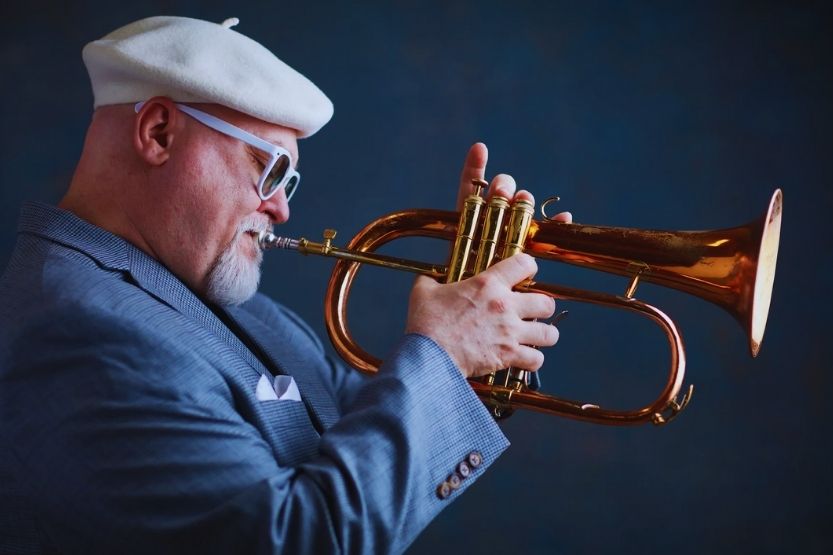
The use of the flugelhorn is narrower and more specific. You can only use this instrument in certain musical settings. But you can also see it in jazz music and classical music. Sometimes, it is given the lead role in these music genres.
This is not a very common instrument that people can pick up and learn to play just as quickly as they can with the guitar. In that sense, the flugelhorn is more for people already playing brass wind instruments.
The people who play the flugelhorn usually know how to play the trumpet in real life. They first learned to play the trumpet, developed some mastery over the instrument before picking up a flugelhorn, and learned to play it.
So, if you want to play the flugelhorn, you should first start learning how to play the trumpet. As you advance in your study, you will know if you need to continue studying the trumpet or jump right on in learning the flugelhorn.
If you are after a unique instrument you can play, you can learn how to play the flugelhorn.
Advantages of Flugelhorn Over Trumpet
While it is not as popular as the trumpet, the flugelhorn offers many things. Here are some of its advantages:
1. More Comfortable to Play
The placement of the pistons of the flugelhorn might be strange, but it is comfortable for instrumentalists with bigger hands. Their larger hands will enable them to play this instrument more comfortably.
2. More Mellow Sound
The mellower sound of the flugelhorn makes it very handy as a backup instrument. It is good at blending and immersing itself with the other instruments. You will seldom hear it popping here and there in a musical piece. Just see and hear how mellow the sound of a flugelhorn is in this video.
Advantages of Trumpet Over Flugelhorn
Click here to see this Eastar Bb Standard Trumpet Set for Beginner on Amazon.
The trumpet is more popular than the flugelhorn because it offers more advantages to the instrumentalist. What are these plusses?
1. Easier to Learn
The best going on for the trumpet is that it is easier to learn than the flugelhorn. That is why it is the most famous member of the brass wind instruments. Many people have picked up this instrument as their first choice.
2. Easier to Play
The trumpet is easier to play because of its smaller size. Any average hand can play its pistons easily because they are also smaller. These factors make the trumpet more virtuosic.
3. Catches the Attention
It attracts the attention of most people because of its loudness. Its sound is also more direct and focused. This is why it is given the lead role in most brass musical compositions and arrangements. Here’s a video that will prove that trumpets can easily attract your attention.
4. Versatile
The trumpet is also very versatile. It can be used in many different music genres, not exclusively on brass music. Because of its popularity, trumpet players enjoy high demand for their services.
So, What’s Your Instrument?
Your choice between trumpet vs flugelhorn will all boil down to your intent. You now know that the flugelhorn is best at blending and harmonizing with other instruments, while the trumpet is best at soloing.
Since it was invented in the late 18th century, the trumpet was always used for soloing. That could not be said of the flugelhorn. The work of the flugelhorn is mostly blending and backing up the other instruments.
If you want to do the solo parts, go for the trumpet. But if you are not much of an attention-getter but only a harmonizer, then your instrument is the flugelhorn. But there’s nothing wrong with being a trumpet player and a flugelhorn player.
Conclusion: Flugelhorn Vs Trumpet – What Is the Difference Between Them?
Their timbers are what make them different from each other. The timber of the flugelhorn is described as fatter, darker, and mellower than the trumpet. Many people have described the sound of the flugelhorn as halfway between a French horn and a trumpet.
The flugelhorn is more challenging to learn than the trumpet. Most people who know how to play the flugelhorn started learning the trumpet first. This indicates that it is easier to learn the trumpet than the flugelhorn.
Related reading:
Jean Paul FH-430 Flugelhorn Specs and Review
Jean Paul TR-330 Student Trumpet Specs and Review
Cornet vs Trumpet – What are the Differences?







